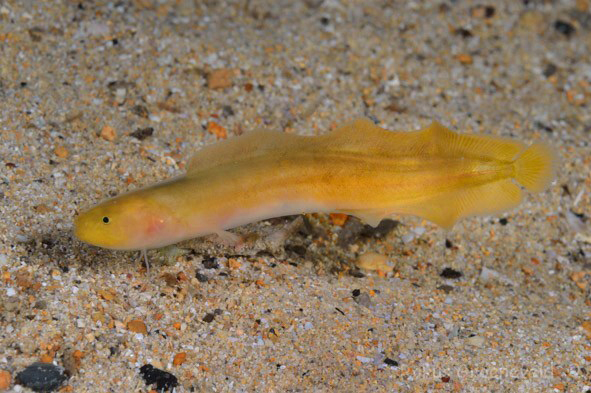- Classification
- ACTINOPTERYGII
- OPHIDIIFORMES
- DINEMATICHTHYIDAE
- Dipulus
- multiradiatus
Slender Blindfish, Dipulus multiradiatus (McCulloch & Waite 1918)
Other Names: Blindfish, Yellow Eelpout

A Slender Blindfish, Dipulus multiradiatus, at Edithburg Jetty, South Australia, March 2018. Source: diverosa / iNaturalist.org. License: CC by Attribution-NonCommercial
Summary:
A secretive yellowish blindfish found on shallow coastal reefs of southern Australia.
This species was previously known as Dermatopsis multiradiatus.
This species was previously known as Dermatopsis multiradiatus.
Cite this page as:
Bray, D.J. 2022, Dipulus multiradiatus in Fishes of Australia, accessed 26 Apr 2024, https://fishesofaustralia.net.au/Home/species/2867
Slender Blindfish, Dipulus multiradiatus (McCulloch & Waite 1918)
More Info
|
Distribution |
Endemic to southern Australia between Kangaroo Island, South Australia, and the Rottnest Island, Western Australia. Inhabits shallow rocky reefs in depths to about 15 m, sheltering beneath ledges and among rubble. |
|
Features |
Dorsal fin 97-112; Anal fin 57-64; Pelvic fin 1; Vertebrae 19-22 + 33-36 = 52-57. Body shallow (8-16% SL), very elongate, compressed; caudal peduncle narrow. Head small (15-22% SL); eyes very small (8-12% HL), directed laterally, covered with skin; mouth large (upper jaw length 43-50% HL), angled obliquely; tip of maxilla extending well beyond eye, hind edge angled obliquely relative to line of upper jaw; each jaw with narrow band of thin depressible canines; lips and chin sculptured, with complex flaps and pores, including large fleshy rosette dorsomesial to anterior nostril; anterior nostril just above upper lip; opercle with stout spine, angled obliquely, tip above upper end of gill opening; gill membranes free from isthmus. Supraorbital pore behind eye present; lower preopercular pores 3, the 2 first tubular; posterior infraorbital pores 3; broad angle on ventral maxilla positioned behind rear of eye; exposed opercular spine bent upwards; lower lip with skin folds; single pair of pseudoclaspers curved, hockey stick-like, thin; penis slightly shorter than pseudoclaspers, with hook at tip; otoliths rounded anteriorly and expanded posteriorly, without postdorsal angle, otolith length to height ratio 2.3-2.4, sulcus wide; each side of head with few small tubular pores, including one above and behind eye but not below and in front of eye, prominent tubular pore immediately above upper end of gill opening. Scales tiny, cycloid, overlapping; cheeks naked; lateral line obscure, high on side anteriorly, curving sharply down to centre of side just beyond tip of pectoral fin, marked by tiny delicate fleshy tubes between scales. Dorsal and anal fins with elongate bases, low, separate from caudal fin; caudal fin rounded. Pelvic fins arising below posterior edge of preopercle, reaching one-fourth to one-third of way to anus. |
|
Feeding |
Radiographs of specimens often show copepods in the gut. |
|
Biology |
Fertilisation is internal and females give birth to live young. McCulloch and Waite (1918) reported that one female specimen (77 mm TL) contained three fully developed embryos, each measuring 28 mm TL. |
|
Remarks |
The poor eyesight in these fishes is undoubtedly overcome by a well-developed system of taste and smell, as indicated by the greatly modified lip structure. |
|
Etymology |
The specific name is from the Latin multiradiatus (= having many rays), in reference to the greater number of dorsal- and anal-fin rays than in Dermatopsis macrodon (its congener at the time the species was described). |
|
Species Citation |
Dermatopsis multiradiatus McCulloch & Waite, 1918, Rec. S. Aust. Mus. 1: 63, Pl. 5 (fig. 4). Type locality: Kangaroo Island, South Australia. |
|
Author |
Bray, D.J. 2022 |
|
Resources |
Slender Blindfish, Dipulus multiradiatus (McCulloch & Waite 1918)
References
Cohen, D.M. 1966. A new tribe and a new species of ophidioid fish. Proceedings of the Biological Society of Washington 79(28): 183-204 figs 1-5. (as Dermatopsis multiradiatus)
Cohen, D.M. & Nielsen, J.G. 1978. Guide to the identification of genera of the fish order Ophidiiformes with a tentative classification of the order. National Marine Fisheries Service (U.S.). Technical Report 417: 1-72 figs 1-103 (as Dermatopsis multiradiatus)
Gomon, M.F. 1994. Families Ophidiidae, Bythitidae, Carapidae. pp. 365-375 figs 326-335 in Gomon, M.F., Glover, C.J.M. & Kuiter, R.H. (eds). The Fishes of Australia's South Coast. Adelaide : State Printer 992 pp. 810 figs. (as Dermatopsis multiradiatus)
Gomon, M.F. 2008. Family Bythitidae. pp. 356-359 in Gomon, M.F., Bray, D.J. & Kuiter, R.H. (eds). Fishes of Australia's Southern Coast. Sydney : Reed New Holland 928 pp. (as Dermatopsis multiradiatus)
Hoschke, A., Whisson, G. & Moore, G.I. 2019. Complete list of fishes from Rottnest Island. pp. 150-161 in Whisson, G. & Hoschke (eds). The Rottnest Island fish book. 2nd ed. Perth, Western Australia : Aqua Research and Monitoring Services.
McCulloch, A.R. & Waite, E.R. 1918. Some new and little known fishes from South Australia. Records of the South Australian Museum (Adelaide) 1(1): 39-78 figs 26-31 pls 2-7 See ref at BHL
Mees, G.F. 1962. Additions to the fish fauna of Western Australia. 3. Western Australian Fisheries Bulletin 9(3): 23-30 fig. 1 (as Dipulus caecus in part)
Møller, P.R., Knudsen, W., Schwarzhans, W. & Nielsen, J.G. 2016. A new classification of viviparous brotulas (Bythitidae) – with family status for Dinematichthyidae – based on molecular, morphological and fossil data. Molecular Phylogenetics and Evolution 100: 391-408 https://doi.org/10.1016/j.ympev.2016.04.008
Møller, P.R. & Schwarzhans, W. 2006. Review of the Dinematichthyini (Teleostei, Bythitidae) of the Indo-west Pacific. Part II. Dermatopsis, Dermatopsoides and Dipulus with description of six new species. The Beagle, Records of the Museums and Art Galleries of the Northern Territory 22: 39-76. See ref at BHL
Nielsen, J.G., Cohen, D.M., Markle, D.F. & Robins, C.R. 1999. Ophidiiform Fishes of the World. An annotated and illustrated catalogue of pearlfishes, cusk-eels, brotulas and other ophidiiform species known to date. FAO Fisheries Synopsis No. 125 Vol. 18. 178 pp. (as Dermatopsis multiradiatus)
Scott, T.D. 1962. The Marine and Freshwater Fishes of South Australia. Adelaide : Government Printer 338 pp. figs. (as Dermatopsis multiradiatus)
Williams, A. 2020. Dermatopsis multiradiatus. The IUCN Red List of Threatened Species 2020: e.T135447628A137379636. https://dx.doi.org/10.2305/IUCN.UK.2020-1.RLTS.T135447628A137379636.en. Accessed on 30 January 2022.







